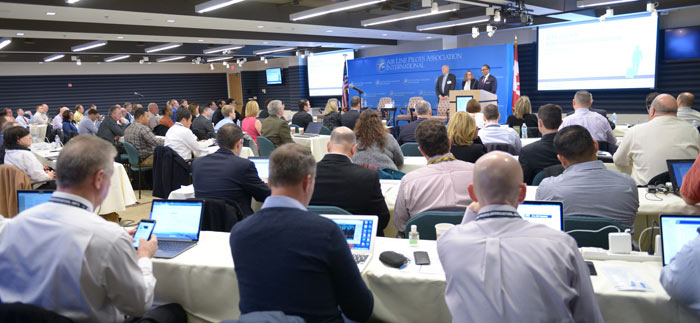Flight Time/Duty Time
By Capt. Don Wykoff (Delta), Flight Time/Duty Time Committee Chairman

Bringing together government and industry stakeholders, ALPA and Airlines for America cohost a flight time/duty time(FT/DT) seminar to share information and collaborate on advancements in FT/DT procedures and policies.
The very creation of ALPA stems from the early days of aviation when airline managements would push pilots to fly beyond their personal limits. In the 1930s, the Association played a pivotal role in establishing Decision 83, landmark legislation that limited flight time for pilots to 85 hours per month. Since then, ALPA has continued its goal of basing duty time and rest on scientific evidence and pilot operational experience.
With the enactment of the Airline Safety and FAA Extension Act of 2010, flight-time/duty-time (FT/DT) limits and minimum rest requirements were updated for pilots who fly passenger operations in the United States. These Part 117 rules took effect in 2014 and are based on scientific findings that address pilot fatigue. While the new regulation isn’t perfect, it’s a significant step in the right direction. Two remaining steps are securing similar new rules for all-cargo and Canadian pilots.
Over the past year, airlines have continued to fine-tune their mandatory fatigue risk management plans (FRMPs). FRMPs describe the operational and functional processes detailing how an airline will manage, monitor, and mitigate day-to-day flightcrew member fatigue. Furthermore, they provide fatigue education and awareness training as well as facilitate a means to evaluate the effectiveness of existing FRMP processes, fatigue education, and the FRMP as a whole.
An airline’s FRMP isn’t written in stone, as it must be updated and submitted for approval every two years. We need these programs to evolve from the framework of the regulation to include the customizable benefits of more advanced fatigue risk management. Going beyond hazard identification and transitional procedures, the data would drive continuous monitoring and managing of scientific-based, fatigue-related safety risks, knowledge, and operational experience to ensure that relevant personnel are performing at adequate levels of alertness.
While the principal function of an Fatigue Safety Action Group (FSAG) is to oversee FRMP development and implementation, its process also has a role in risk identification and mitigation in a more traditional, prescriptive approach. Using the FSAG in this manner provides the operator and pilot group representative a method to identify and mitigate a fatigue-related operational risk well before it becomes a significant, disruptive hazard.
Because fatigue management is a shared responsibility and requires an effective safety reporting culture, an airline’s FSAG should include representatives of all stakeholder groups: management, scheduling staff, and crewmember representatives. An effective FSAG should also gather input from other individuals as needed to ensure that the group has appropriate access to scientific, statistical, and medical expertise. ALPA has many pilot groups that have integrated an FSAG-type approach and are finding the adaptive and holistic approach to scheduling beneficial for both pilots and schedulers.
Earlier this year, ALPA’s Flight Time/Duty Time Committee cohosted with Airlines for America a two-day seminar on fatigue management in which we discussed FRMPs and FSAGs in detail. More than 120 pilots, airline industry representatives, consultants, and government officials attended the event and shared experiences, exchanged strategies, and collaborated on advancements in FT/DT policies and procedures. We’re constantly striving to improve methods that identify and mitigate fatigue-related risks in our daily operations, and educating everyone involved in fatigue management has been one of the best strategies in defending against its risks.
ALPA’s Legal Department continues to support the committee’s work by sharing legal interpretations from the FAA regarding Part 117. This information along with ALPA’s Guide to Part 117 Flight-Time Limitations and Rest Requirements (PDF) can be accessed by members at www.alpa.org/FTDT. In addition, ALPA’s IT Department continues to fine-tune ALPA’s Part 117 calculator app, available at www.alpa.org/apps, which helps pilots track their maximum flight- and duty-period hour limits and day-rest period and alerts them to potential limit violations.
We’ve made solid progress in effectively implementing FAR 117. However, more work in the U.S. all-cargo segment and in Canada is needed, and we’ll continue pressing for improvements. Collaboratively finding joint solutions remains critical to the future of effective and meaningful fatigue management and safer skies for everyone.

